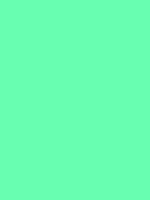#68feb1 Color Information
In a RGB color space, hex #68feb1 is composed of 40.8% red, 99.6% green and 69.4% blue. Whereas in a CMYK color space, it is composed of 59.1% cyan, 0% magenta, 30.3% yellow and 0.4% black. It has a hue angle of 149.2 degrees, a saturation of 98.7% and a lightness of 70.2%. #68feb1 color hex could be obtained by blending #d0ffff with #00fd63. Closest websafe color is: #66ff99.
-
- R 41
- G 100
- B 69
-
- C 59
- M 0
- Y 30
- K 0
● #68feb1 color description : Soft cyan - lime green.
#68feb1 Color Conversion
The hexadecimal color #68feb1 has RGB values of R:104, G:254, B:177 and CMYK values of C:0.59, M:0, Y:0.3, K:0. Its decimal value is 6880945.
| Hex triplet | 68feb1 | #68feb1 |
|---|---|---|
| RGB Decimal | 104, 254, 177 | rgb(104,254,177) |
| RGB Percent | 40.8, 99.6, 69.4 | rgb(40.8%,99.6%,69.4%) |
| CMYK | 59, 0, 30, 0 | |
| HSL | 149.2°, 98.7, 70.2 | hsl(149.2,98.7%,70.2%) |
| HSV (or HSB) | 149.2°, 59.1, 99.6 | |
| Web Safe | 66ff99 | #66ff99 |
| CIE-LAB | 90.32, -57.132, 25.13 |
|---|---|
| XYZ | 49.083, 76.997, 53.868 |
| xyY | 0.273, 0.428, 76.997 |
| CIE-LCH | 90.32, 62.414, 156.257 |
| CIE-LUV | 90.32, -63.491, 45.907 |
| Hunter-Lab | 87.748, -53.712, 25.026 |
| Binary | 01101000, 11111110, 10110001 |
Color Schemes with #68feb1
Alternatives to #68feb1
Below, you can see some colors close to #68feb1. Having a set of related colors can be useful if you need an inspirational alternative to your original color choice.
#68feb1 Preview
This text has a font color of #68feb1.
<span style="color:#68feb1;">Text here</span>This paragraph has a background color of #68feb1.
<p style="background-color:#68feb1;">Content here</p>This element has a border color of #68feb1.
<div style="border:1px solid #68feb1;">Content here</div>.text {color:#68feb1;}.background {background-color:#68feb1;}.border {border:1px solid #68feb1;}Shades and Tints of #68feb1
A shade is achieved by adding black to any pure hue, while a tint is created by mixing white to any pure color. In this example, #000502 is the darkest color, while #f0fff7 is the lightest one.
-
#000502
#000502rgb(0,5,2) -
#00180c
#00180crgb(0,24,12) -
#002c15
#002c15rgb(0,44,21) -
#003f1f
#003f1frgb(0,63,31) -
#015329
#015329rgb(1,83,41) -
#016632
#016632rgb(1,102,50) -
#017a3c
#017a3crgb(1,122,60) -
#018d45
#018d45rgb(1,141,69) -
#01a14f
#01a14frgb(1,161,79) -
#01b458
#01b458rgb(1,180,88) -
#01c862
#01c862rgb(1,200,98) -
#01db6b
#01db6brgb(1,219,107) -
#02ef75
#02ef75rgb(2,239,117)
-
#07fd7f
#07fd7frgb(7,253,127) -
#1afd89
#1afd89rgb(26,253,137) -
#2efe93
#2efe93rgb(46,254,147) -
#41fe9d
#41fe9drgb(65,254,157) -
#55fea7
#55fea7rgb(85,254,167) -
#68feb1
#68feb1rgb(104,254,177) -
#7bfebb
#7bfebbrgb(123,254,187) -
#8ffec5
#8ffec5rgb(143,254,197) -
#a2fecf
#a2fecfrgb(162,254,207) -
#b6ffd9
#b6ffd9rgb(182,255,217) -
#c9ffe3
#c9ffe3rgb(201,255,227) -
#ddffed
#ddffedrgb(221,255,237) -
#f0fff7
#f0fff7rgb(240,255,247)
Tones of #68feb1
A tone is produced by adding gray to any pure hue. In this case, #aeb8b3 is the less saturated color, while #68feb1 is the most saturated one.
-
#aeb8b3
#aeb8b3rgb(174,184,179) -
#a8beb3
#a8beb3rgb(168,190,179) -
#a2c4b3
#a2c4b3rgb(162,196,179) -
#9dc9b2
#9dc9b2rgb(157,201,178) -
#97cfb2
#97cfb2rgb(151,207,178) -
#91d5b2
#91d5b2rgb(145,213,178) -
#8bdbb2
#8bdbb2rgb(139,219,178) -
#85e1b2
#85e1b2rgb(133,225,178) -
#7fe7b2
#7fe7b2rgb(127,231,178) -
#7aecb1
#7aecb1rgb(122,236,177) -
#74f2b1
#74f2b1rgb(116,242,177) -
#6ef8b1
#6ef8b1rgb(110,248,177) -
#68feb1
#68feb1rgb(104,254,177)
Color Blindness Simulator
Below, you can see how #68feb1 is perceived by people affected by a color vision deficiency. This can be useful if you need to ensure your color combinations are accessible to color-blind users.
